| This article is a featured article, one of our top articles. |
| City | |||||||
|
| |||||||
| Name | Hurbanova | ||||||
|---|---|---|---|---|---|---|---|
| Hexacode | OC-HU-01 | ||||||
| Population | 40,243[1] | ||||||
| Language(s) | English, Oceana (Narasha 'Oshenna) | ||||||
| Location | Oceana (Peace Island) | ||||||
| Next to | Drake Town, Millstreet | ||||||
| Nicknames | Hurbanovo | ||||||
| Saint(s) | Pope Urban I[2] | ||||||
| Anthem | Kem that lew is espavat | ||||||

| |||||||
Hurbanova, in the Oceana language also but less frequently referred to as Hurbanoft, is a large Lovian city located on Peace Island, and the capital of the State of Oceana. The town was founded in 1881 and has a very rich history, including migration waves from Eastern Europe. The region has been strongly influenced by several European cultures. Possible language problems can and have arisen already as a result of the usage of the language of Oceana (Narasha 'Oshenna).
Hurbanova is surrounded by an environmentally significant natural area and is known for its quietness and its wood-dominated traditional architecture. The town, and perhaps the state in its totality, has significantly higher rates of religiosity and tends to be more conservative.
Etymology and name[]
 Main article: Etymology of Hurbanova.
Main article: Etymology of Hurbanova.
Many theories exist about the name origin of 'Hurbanova'. Some suggest its name derives from Pope Urban I, others think it has Latin origins, still others argue Hurbanova is of Slovak origin. Other linguists link the name to either the Oceana dialect or the Slovak Zamokkian dialects.
Prior to 1882, the city was called Calava. The origin of this name is also unclear.
Pronunciation[]
The name is pronounced by native speakers of English as [ɦʏbɑːˈnɔ̃ːʋɑ] or [hɝːbɑːˈnouʋə] (IPA). Speakers of Oceana are more likely to pronounce it like this: [hyʁbaˈnovɑ]. Hurbanoft is pronounced like this: [ˈhyʁbano(f)c]. The latter name is very unlikely to be used by speakers of English.
Town map[]
Below is a map showing the direct environment of Hurbanova. Only Millstreet, Newport, Downtown and Drake Town are considered neighborhoods.
| Overbanken | Treyest Forest | |||
| Hurbanova Stream | ||||
| Millstreet | Newport | Slowane | Eastfield | |
| Downtown | Drake Town | Shkola Hurbanovni | ||
| Fromfield | Lessingshoe [3] | |||
The town of East Hills also used to belong to Hurbanova, but is now governed separately. Scotland and Slowane were Hurbanovan hamlets that are now practically deserted.
Downtown[]
| Pacific Ocean | Oceana Beach | Railway: Peace Island Railway | |||||||||||
| 1 Vlackstreet: Hurbanova Railway Station |
5 Vlackstreet: Post Office Hurbanova |
7 Vlackstreet: De Limburger |
9 Vlackstreet: Wooden Hurbanovan Bank |
11 Vlackstreet: Prach |
*3 | 15 Vlackstreet Parking Hurbanova | |||||||
|---|---|---|---|---|---|---|---|---|---|---|---|---|---|
| Vlackstreet / Vlacest | |||||||||||||
| 2 Vlackstreet Oceana Hotel |
4 Vlackstreet L-Souvenirs |
1* | 6 Vlackstreet Bart Koenen |
8 Vlackstreet SuperAndro |
10 Vlackstreet The Landmark Hurbanova |
12 Vlackstreet Ben |
2* | 14 Vlackstreet Maxi |
16 Vlackstreet King Dimitri I fanfare | ||||
| 1 Oceana Side-street Old Oceana Hotel |
3 Oceana Side-street Swift Oil |
5 Oceana Side-street Oos Wes Ilava |
7 Oceana Side-street FOR SALE (Latin Memorial House) |
9 Oceana Side-street Marius Stefan |
11 Oceana Side-street Kim Dae-su |
13 Oceana Side-street Anna Maria Whithdonck-Malsky |
15 Oceana Side-street Grey Lounge | ||||||
| Oceana Side-street / Zaitestreate 'Oshenna | |||||||||||||
| 2 Oceana Side-street Ye Olde Pub |
4 Oceana Side-street Supermarket Doshmat |
6 Oceana Side-street Oceana Capitol Oceana state government |
10 Oceana Side-street Federal Police Headquarters Oceana Police Traffic Unit |
12 Oceana Side-street UPChurch Hurbanova |
14 Oceana Side-street Horton11 |
16 Oceana Side-street Philip Bradly-Lashawn | |||||||
| 1 Danish Avenue Butique |
3 Danish Avenue Aventis |
Hurbanova Central Park |
13 Danish Avenue Bistro 13 |
15 Danish Avenue JamalH | |||||||||
| Danish Avenue / Daynish Cesta | |||||||||||||
| 2 Danish Avenue Saint Urban's Cathedral Bishopric of Lovia |
6 Danish Avenue Tourist Information |
8 Danish Avenue Bèr Mans |
10 Danish Avenue That Varen |
12 Danish Avenue Hurbanova Medical Center |
14 Danish Avenue The Old Oceans' Farm | ||||||||
| 1 Wallstreet: Monastery Park |
Market / Trh | ||||||||||||
| Wallstreet / Wallcest | |||||||||||||
| Oceana Wall | |||||||||||||
- Old Wharf / That Old Wof
- Mayores Road / Piesocesta o'Mayores
- Prachstreet / Prachcesta
History[]
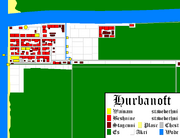
Hurbanova in 1884.

Hurbanova back in the old days, a farm in 1882.
Hurbanova is one of the oldest towns of Lovia. The town was founded in 1881. The reason why people started to live here was because they found something special, the Oceana Wall. This brick wall was already built before the first people arrived in Lovia. Even today this wall is a mystery. Most buildings in the town are old and made of wood.
When the town was built in 1881 the shoreline was situated a few meters to the east, where nowadays lays the so-called Old Wharf. The Old Wharf served as a load wall. This wharf was really a wall with a street on top of it. The Old Wharf was used during one year when the harbor of Hurbanova was filled and people start to live on the place where once was the harbor.
Hurbanova has been built together with a village 2 kilometers away from the town, Scotland. Scotland was a less wealthy village with a population of about 40 people of which most where from Scots or Irish origin. The only thing left of the village of Scotland are the ruins of an unfinished castle. Scotland was left in 1904 for unknown reason. One possible reason is that the village was not protected from the floods of a nearby river. Scotland had 14 houses, 36 stables, an unfinished castle of someone called McLeid, a well, a monastery and a chapel.
In 1884 there was an enormous fire which caused the destruction of almost 90% of all buildings in Hurbanova. Almost 39 people died of suffocation because they were trapped in the shecks. The population decreased from 201 to 162 and most people were homeless. The cause of the fire has never been found out and it is possible it was done on purpose. The population didn't reach the 200s again until 1898. The town was renewed shortly after. Though the fire destroyed almost all buildings, all new buildings were made of wood too. This was done because the mayor of that time, Rashkolit' Shadenki did not want to change the town's look. As he said: We shall not betray our city. Or the tourists will leave us and go to Noble City.[4] All Hurbanovos agreed with him and started to rebuild the houses and monuments. New mines were built outside the town, so workers couldn't sufficate again if there was a new fire in Hurbanova. Fortunately, there would never come a fire on this scale in Hurbanova again.
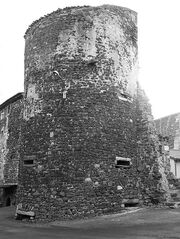
The Slinkni Branan, 1917.
Until 1917 one of the four original town gates, the Slinkni Brana ('Gate of the Sun'), was still standing. Hurbanova has always been part of Lovia, but was not an official town until 1887 when a nationwide referendum was held. 95% of the Lovians supported. There never was any trouble because the Lovians helped rebuilding the town after the 1884 fire. The gates were built by the third mayor, Kelový, to prevent that in times of war the town would be destroyed. The complete defence of Hurbanova of that time was a part of the Oceana Wall, a moat, a river and 4 gates. In 1917 the government of Oceana decided to blow up the remaining gate. This resulted in protests by the inhabitants and the monastery. One picture remains of the gate, on a moment the gate was already damaged severely and only one of the two towers was still standing. Even though many people were against the destruction of the gate the state government decided to do it and on March 5, 1917, the remainings of the gate were blown up. The moat was later on filled and there is almost nothing left of the original fortification.
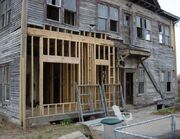
A building being renovated.
In June 2005 the renovation of the town began. It has been estimated 30% of all the buildings were heavily affected by woodworm. It's expected that the renovation will take two years and ten months, so all the work should be done by April 2008. The damaged buildings repel the tourists from coming to Hurbanova. This has been said by the ex-mayor Kčalit' Úskalie. He said: Those woodworms eat our houses! If this keeps going on like this forever I'd rather kill them one by one with my own bare hands![5]
Archeologists are currently searching for more evidence that indicate there were people in Lovia before the Founding Fathers. The Oceana Wall is "the evidence" according to most Hurbanovans. Until now, nobody really had an answer to the question how the wall came there. Recently, an inhabitant of Hurbanova, Zabel Šlanovič said he had found some pottery near the wall. Experts from universities all over came to Hurbanova to investigate this pottery. Research made clear the pottery was over 1000 years old, almost 750 years before western people went to Lovia for the first time. Inhabitants claimed it was Lovian, while archeologists thought it was from European origin, brought here by the first migrants.
Mining history[]
Coals, as well as gold and silver (though very little) were found in Hurbanova. As soon as 1877 the first mines were dug, even before the foundation of the town. Most people lived in small houses near the mines or in Noble City. Most mines were closed in the 60s and 70s of the twentieth century, though some mines are still in use. Oceana was one of the few areas of Lovia where mining became that important. Most wealth in Hurbanova nowadays comes from the mining industry.
Nowadays, there are still two mines opened, the Zlate Mine and the Lovian State Mine. The Hurbanovan economy depends for a large part on these mines. Almost 5% of all inhabitants of Hurbanova work in them, most other miners live in Noble City. Once nearly 100% of the population of Hurbanova worked in the mines, but this changed when the first women arrived.
The following mines are situated near Hurbanova:
| Opened in | Name | Company | Type of mining | Closed in | State today |
|---|---|---|---|---|---|
| 1877 | Skalit' Mine | Hurbanovan Mining | coals | 1958 | The mine is flooded with water and isn't accessible anymore. |
| 1878 | Robit' Mine | Hurbanovan Mining | coals | 1968 | The mine is flooded with water and isn't accessible anymore. |
| 1879 | Lashbo Mine | Hurbanovan Mining | coals | 1964 | The mine functions as a working museum now. |
| 1881 | Pope Urban I Mine | Hurbanovan Mining | coals | 1972 | The mine is flooded with water and isn't accessible anymore. |
| 1883 | Skalit' Mine | Hurbanovan Mining | coals | 1958 | The mine is flooded with water and isn't accessible anymore. |
| 1885 | Rashlit Askolit' I Mine | Hurbanovan Mining | coals | 1975 | The mine is flooded with water and isn't accessible anymore. |
| 1886 | Rashlit Askolit' II Mine | Hurbanovan Mining | coals | 1989 | The mine functions as a museum. |
| 1889 | Seltný Mine | Hurbanovan Mining | coals | 1974 | The mine is flooded with water and isn't accessible anymore. |
| 1894 | Strobro Mine | Bergen Group | silver | 1936 | The mine is still productive. |
| 1904 | Rashlit Askolit' III Mine | Hurbanovan Mining | coals | 1963 | unknown |
| 1908 | Rashlit Askolit' IV Mine | Hurbanovan Mining | coals | 1968 | unknown |
| 1915 | Zlate Mine | Zlate Mining | gold | still open | The mine is still productive. |
| 1932 | Lucky Rock Mine | unknown | coals | unknown | Location of the mine is unknown.[6] |
| 1948 | Lovian State Mine | Hurbanovan Mining | coals | still open | The mine is still productive. |
Crisis[]
Under Mayor Oos Wes Ilava, who ruled Hurbanova from 2007 until April 2008, the town grew a lot. Not in size, but in inhabitant figures and historic value. With the renewal of the monuments, the town upgraded to a popular tourist location. In March 2008, a crisis arose in Hurbanova. Mayor Ilava and the Adlibitan Alexandru Latin declared the independence of Hurbanova, resulting in an interwikiwide crisis. They were both banned shortly and all diplomatic relations were heavily damaged. The Mayor had to step down and Ben Opať took over the office. The Federal Police locked off the town for a while because of the possible threats.
After the crisis[]
Hurbanova made progress after the crisis and plans for a new neighborhood came. The main function of this neighborhood is destressing the too crowded old part of the town. The new neighborhood was named Drake Town. The ruins of the Slinkni Branan, which lay there, weren't demolished but the Slinkni Branan were rebuilt.
Later on another neighborhood would follow, namely Millstreet. In 2010 Hurbanova was twinned with the historic Brunanter city of Grijzestad; founded in 1411 it is one of the most historically significant places in its country, like Hurbanova. Also, on November 14th, 2012, the Congress allowed Hurbanova to become a city, with the addition of Overbanken as a neighborhood.
From May until June 2014 the city was under control of Burenia, for more information see Burenian invasion of Lovia.
Anthem[]
Hurbanova has had its own anthem since 1894. The text was written by P.L.Q.C. Úskalie and translated to English by C.L. Easterfields, the music is by H. Sauren, who also wrote many famous country songs of Hurbanova. The anthem is called Kem that lew is espavat (While that lion is asleep)
Demographics[]
Of the 37,472 inhabitants of the Hurbanova district, 12,635 live in Downtown Hurbanova. According to the 2015 census, the racial make-up of Downtown Hurbanova was 12,386 white (98,03%), 109 asian-pacific (0,86%), 48 black (0,38%), and 92 undefined (0,73%); ethnically there were 6,711 Oceana (53,11%), 1,754 Lovians (13,88%), 1,231 Limburgish people (9,74%), 863 Romanians (6,83%), 854 Slovaks (6,76%), 288 Dutch people (2,28%), 173 British people (1,37%), 163 Americans (1,29%), 128 Poles (1,01%), 108 Russians (0,85%), 72 Koreans (0,57%), 46 Scandinavians (0,36%), 41 Bosnians (0,32%), 29 Chinese people (0,23%), and 174 others (1,38%). The first-language distribution was recorded as 5,337 English (42,24%), 2,244 Hurbanovan English (17,76%), 1,802 Oceana (14,26%), 1,014 Limburgish (8,03%), 961 Slovak (7,61%), 702 Romanian (5,56%), 133 Dutch (1,05%), 90 Russian (0,71%), 81 Polish (0,64%), 80 other Germanic (0,63%), 69 Korean (0,55%), 29 Chinese (0,23%), and 93 other (0,74%). The distribution of religious affiliations was 9,301 Roman Catholic (73,61%), 803 Romanian Orthodox (6,36%), 251 United Protestant (1,99%), 126 Evangelic-Christian (1,00%), 84 Lutheran (0,66%), 61 Dutch Protestant (0,48%), 58 Cheondist (0,46%), 52 other Orthodox-Christian (0,41%), 38 other Protestant (0,30%), 22 Buddhist (0,17%), 78 other (0,62%), and 1,761 with no religious affiliation (13,94%).
Geography[]
Hurbanova lies within the green and humid state of Oceana, on Peace Island. The town is surrounded by many terrestrial biomes. In the north a quite flat agricultural area is situated and in the south the town is isolated by the Oceana Wall. The only roads connecting the town with the other Lovian locations are situated in the east. Those roads pass through the temperate coniferous forests. In the west the Oceana Beach and the Pacific Ocean are situated.
Surrounding area[]
The area surrounding Hurbanova is marked by the coniferous forests, very enjoyable for a walk. There are many ancient coal mines which might be dangerous. In the last twenty years 27 tourists, 4 locals and 42 people from other places of Lovia lost their lives because they fell into a mine shaft. If you want to see a mine with your own eyes you can visit one of the still functioning labor museums.
You can visit the Oceana Beach at any time of the year. You can go fishing, diving the Oceana Reef, swimming and much more. The beach is at its narrowst point only one meter and 74 centimeters wide and at its widest point it's about 12 meters. The most visited area of the beach is the Hurbanovan Beach which lies adjacent to the Oceana Hotel and the Supermarket Doshmat.
Other places near Hurbanova that you might want to see, are the Isle of London and the Isle of Frisco, off the coast. These islands form the City Archipelago. Once there were three islands. The third island, which sank after an earthquake in 1903, was the only populated island. Its name was the Isle of Bratislava. All people survived the earthquake, but were once was the island now is a muddy ground. The Oceana people call this That Wodate Oster, the wet island. Nowadays, none of the isles is inhabited.
The center of the Downtown built-up area is located at approximately 5 meters high.
Of the 16,083 functioning registrated buildings in Downtown Hurbanova, 8,402 have a residential designation, 3,214 are stalls, sheds or workhouses, 308 have a religious designation, 2,551 are shops or services buildings, 893 are governmental buildings, and 715 are undefined.
Tourism[]
Hurbanova is one of the best developed tourist locations of Lovia. It's popular during summer holidays, because of the beautiful and extremely clean beaches. Next to these beaches, there are a few small hotels and the possibility to shop. Hurbanova is a member of the Historic Towns Association.
Places of interest[]
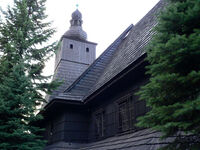
The Saint Urban's Cathedral houses the Catholic church authorities of Lovia
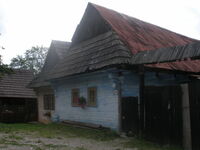
The Old Oceana Hotel
Hurbanova has a rich history, so it has got some places of interest worth visiting:
- Saint Urban's Cathedral (formerly known as Hurbanova Town Hall or Oceana Town Hall): This building used to house the local authorities of the state of Oceana and the town of Hurbanova. It's a wooden building that had been a church until 1963. It has been renovated in 1974 and became a cathedral in 2011.
- The Old Oceans' Farm is a very old farm on the border of the town. The Old Oceans' Farm was one of the oldest buildings in Oceana. The exact date is unknown; probably in the 1890s. Nowadays, it is the town's community center. Many youngsters come here on a daily base. Another function of the building is housing the town's primary school.
- The Hurbanova Central Park lies in the middle of town and has a yard and a couple of trees surrounding it.
- The mysterious Oceana Wall is probably older than 500 years and could have been built before any people from "the known world" came to Lovia.
- The Oceana Capitol (formerly known as Oceana Court House) was where the lawsuits of the Oceana State Court take place. It was built in 1902 and is a real attraction. The building is almost entirely built with lumber. In 2011 it has become the building where the administration of the state of Oceana houses.
- Old Oceana Hotel is the town's oldest hotel. It has been built in 1898 as a farm and has been renovated in 2004. It became a hotel in 1975. Like most other buildings it's made of wood except for the windows. Even the floors and the cellar are made of wood.
- Post Office Hurbanova or Hurbanova Post Office is the local post office, situated near the railway. It was built in 1882, which makes it one of the oldest buildings of Hurbanova. It has been renovated in 1923 and is made out of wood.
- The Hurbanova Railway Station is an old railway station built in 1914. It has been renovated in 1957 and 2007. The building is often been called the Mail Station because the mail used to arrive here. Nowadays many mail goes by car.
Education[]
The King Arthur II School offers primary education to the Hurbanovan pupils. It also provides secondary education. Drake Secondary School is another well-known high school in Drake Town.
After high school, most students go to Blackburn University, Noble City. The Shkola Hurbanovni wants to expand this year in order to provide higher education in Hurbanova.
Media[]
The local Hurbanovan newspaper is the Hurbanova Novine, written in English and the local language.
Economy[]
Most of the inhabitants of Downtown Hurbanova are employed in services, retail, mining, and production industries. According to the 2013 census, the working population is 8,603 (67,7%), of which 524 have no registrated jobs (6,1%) and 992 are unemployed (11,5%). In the entire city's built-up area, the working population is 23,711 (68,1), of which 1,734 have no registrated jobs (7,3%), and 2,195 are unemployed (9,3%).
Politics[]
Now follows the voting results for the local State Elections in Downtown Hurbanova:
| Party | 2012[7] | 2013 | F2015 |
|---|---|---|---|
| CCPL | 2,188 | 2,566 | 2,728 |
| PNO | 1,974 | 398 | 516 |
| OSB | 2,288 | 1,322 | 1,385 |
| NPO | 1,044 | 890 | 802 |
| LMP | 1,192 | 816 | 932 |
| RTP | 329 | 912 | 1,211 |
| GP | 74 | 1,241 | 920 |
| KNPO | - | 1,014 | 633 |
| MLPE | - | 153 | - |
| SP | 311 | 177 | 220 |
| SLP | - | 7 | 7 |
| DV | - | 3 | - |
| UC | - | 15 | 31 |
| LEP | - | - | 11 |
| Valid | 9,400 | 9,514 | 9,396 |
| Blank | 42 | 53 | 34 |
| Invalid | 56 | 76 | 71 |
| Votes cast | 9,498 | 9,643 | 9,501 |
| Entitled to vote | 10,922 | 10,418 | 10,673 |
Transportation[]
There is a railway station in town and the Emerald Railway to East Hills and the Oceana State Line have their terminus at Hurbanova.
The buslines in and around Hurbanova used to be offered by the public transportation company Interbus, but since 2013, there are several bus lines operated by the Bus Service Oceana, as well as a summer bus line from Hurbanova to Ben's Beaver River Camping.
All lines operated by Bus Service Oceana that run from, to, and through Downtown Hurbanova are:
- Line 10: Hurbanova to East Hills (buses for sixteen to thirty-five travellers);
- Line 11: East Hills to Hurbanova (buses for sixteen to thirty-five travellers);
- Line 12: Hurbanova to East Hills (buses for sixteen to thirty-five travellers);
- Line 13: East Hills to Hurbanova (buses for sixteen to thirty-five travellers);
- Line 20: Hurbanova to Dien Village (buses for eight to sixteen travellers);
- Line 21: Dien Village to Hurbanova (buses for eight to sixteen travellers);
- Line 22: Hurbanova to Newmouth (buses for eight to sixteen travellers);
- Line 23: Newmouth to Hurbanova (buses for eight to sixteen travellers);
- Line 30: Hurbanova to Noble City (buses for sixteen to thirty-five travellers);
- Line 31: Noble City to Hurbanova (buses for sixteen to thirty-five travellers);
- Line 44: Boynitz to Hurbanova (buses for eight to sixteen travellers; only early in the morning);
- Line 50: Overbanken Airport to Scotland (buses for sixteen travellers; departs every thirty minutes);
- Line 50: Scotland to Overbanken Airport (buses for sixteen travellers; departs every thirty minutes);
- Line 60: Hurbanova to East Hills and Lovian State Mine (buses for thirty-five travellers; only stops at selected stops; departs every two hours);
- Line 61: Lovian State Mine to East Hills and Hurbanova (buses for thirty-five travellers; only stops at selected stops; departs every two hours).
- Line 100: Hurbanova to Ben's Beaver River Camping (buses for sixteen travellers; only in the tourist season, and does not stop at all stops);
- Line 101: Ben's Beaver River Camping to Hurbanova (buses for sixteen travellers; only in the tourist season, and does not stop at all stops).
The following bus stops lie within Downtown Hurbanova's zone of habitation: Hurbanova Vlackstreet, Oceana Capitol, and Saint Urban's Cathedral.
There is also an airport service, Overbanken Regional Airport.
Famous Hurbanovans[]
Many famous people from Lovia are born or have lived in Hurbanova. The following people have lived or live in Hurbanova:
- 1812-1909: Rashkolit' Shadenki, Slovak origin mayor from 1883 to 1886
- 1830-1890: Georg Ludvík Telemann, one of the first Lovian composers.
- 1839-1909: Anton Hlinka, discovered the Isle of Bratislava
- 1885-1933: James M. Jackson, writer
- 1898-1972: George Likewise, mayor from 1944 to 1945, singer-songwriter of country music.
- 1902-1969: Oscar O'Neill, poet
- 1932-1976: Ben Hlond, serial killer.
- 1946-2010: A.M. Donia, LCP-politician living in Donia Castle in the Emeralds, head of the Donia Clan - greatly disliked by most Hurbanovans[8]
- 1947-present: Pažkolit Úskalie, fisherman, discovered the Oceana Reef in 1974.
- 1963-present: Andy Petrescu, a musician and songwriter.
- 1971-present: Donald Ský, an international darts player
- 1972-present: Oos Wes Ilava, mayor and Minister
- 1972-present: Alexandru Latin, politician and businessman
- 1975-present: Philip Bradly-Lashawn, sportsman and royal bastard
- 1979-present: Patrick West, politician and chairman of the RTP
- 1981-present: Pahor Podgorie, rapper and member of the hip hop band Naselni Jazzeek
- 1982-present: Marki Jólkavský, rapper and member of the hip hop band Naselni Jazzeek
- 1982-present: Alesh or Ladislav Alexej Stefanik, poet
- 1983-present: Mihály Szentes, disc jockey of the hip hop band Naselni Jazzeek
Mayors
 Main article: List of Mayors of Hurbanova.
Main article: List of Mayors of Hurbanova.
Sister cities[]
 Port-Girana, Cettatie
Port-Girana, Cettatie Gäörne, Mäöres
Gäörne, Mäöres Grijzestad, Brunant
Grijzestad, Brunant Mofert, Netherlands
Mofert, Netherlands Nyttfron, Libertas
Nyttfron, Libertas Strivica, Juliana
Strivica, Juliana
References and notes[]
- ↑ Of which 37,472 in built-up areas and 2,771 in rural areas. Downtown Hurbanova has 12,635 inhabitants. East Hills (canton) has been excluded. Oceana Demographic Center (2015).
- ↑ Governor Andy McCandless removed him as the official state-recognized patron of Hurbanova in 2010, for secularity's sake. The Roman Catholic community still regarded Pope Urban as the patron of Hurbanova. On February 16, 2011, Governor Oos Wes Ilava again made him the official state-recognized patron.
- ↑ The hamlet of Scotland is located in the area of Lessingshoe.
- ↑ Original text: We buet nada do un shmean to oshine mest. O that obdif buet got do That Mest.
- ↑ Original text: Thie woodcherref chest 'oshine sheals! As that so pokrochoved am got chelft 'on!
- ↑ Some people say the mine has never existed, but there are unpublished documents pertaining information about a Lucky Rock Mine.
- ↑ Voting results for these elections may not be fully accurate, as some people were still registrated in Hurbanova and East Hills, due to the transition to the district system. As a result, the amount of registered voters in the hamlet is lower than the actual amount; while some votes in built-up areas are actually votes from hamlets.
- ↑ [1]
See also[]
| Historic Towns Association | |
|
Lovia - Noble City - Newhaven - Hurbanova |




